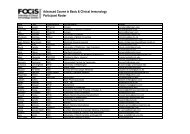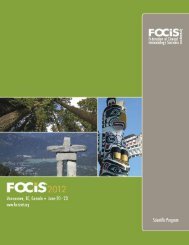Oral Presentations - Federation of Clinical Immunology Societies
Oral Presentations - Federation of Clinical Immunology Societies
Oral Presentations - Federation of Clinical Immunology Societies
You also want an ePaper? Increase the reach of your titles
YUMPU automatically turns print PDFs into web optimized ePapers that Google loves.
S24 Abstracts<br />
Massachusetts General Hospital, Boston, MA, Leigh Field,<br />
Pr<strong>of</strong>essor, Department <strong>of</strong> Medical Genetics, University <strong>of</strong><br />
British Columbia, Vancouver, BC, Canada, Flemming Pociot,<br />
Pr<strong>of</strong>essor, Steno Diabetes Center, Gent<strong>of</strong>te<br />
Type 1 diabetes (T1D) is a complex disease believed to<br />
result from interactions between multiple risk-conferring<br />
genes and environmental factors. In order to further<br />
investigate the genetic contribution to T1D we genotyped a<br />
case–control material for 58,000 SNP and tested these for<br />
association to disease. The first phase <strong>of</strong> the study comprised<br />
<strong>of</strong> thorough quality tests <strong>of</strong> the data for issues such as sample<br />
contamination, inbreeding, low genotyping rates, relatedness<br />
and population stratification which led to samples being<br />
excluded. SNPs were removed for failing HWE in controls, low<br />
genotyping rate, differences in missing genotyping rates<br />
between cases and controls and being non-polymorphic,<br />
which contributed to significant false positive findings. After<br />
ensuring the highest quality <strong>of</strong> the data-set the remaining<br />
52,000 SNPs and 605 individuals were analysed using basic<br />
allelic and model-based tests <strong>of</strong> association corrected for<br />
multiple testing and using permutation with empirically<br />
corrected p-values. Furthermore we performed genomewide<br />
sliding-window haplotype tests and full pair-wise test<br />
for epistasis across the genome. We also performed the same<br />
analyses for markers in 12 linkage regions previously reported<br />
in T1D. Every individual test confirmed the importance <strong>of</strong> the<br />
HLA region on chromosome 6p21.3 for developing T1D. In<br />
combination these tests point to other chromosomal regions<br />
contributing to T1D susceptibility. The significant findings<br />
will be followed up in a larger case–control material to<br />
confirm these present results. In addition this study has<br />
demonstrated the importance <strong>of</strong> high quality data for<br />
avoiding false positive findings when performing association<br />
analyses in complex diseases.<br />
doi:10.1016/j.clim.2007.03.235<br />
F.23 iNKT Cell Regulation <strong>of</strong> Type 1 Diabetes<br />
Dalam Ly, PhD Candidate, Robarts Research Institute,<br />
London, ON, Canada, Qing Sheng Mi, Research Associate,<br />
Robarts Research Institute, London, ON, Canada, Shabbir<br />
Hussain, Research Associate, Robarts Reseach Institute,<br />
London, ON, Canada, Terry L. Delovitch, Pr<strong>of</strong>essor, Robarts<br />
Research Institute, London, ON, Canada, Steven A. Porcelli,<br />
Pr<strong>of</strong>essor, Albert Einstein College <strong>of</strong> Medicine, Bronx, NY<br />
The pathogenesis <strong>of</strong> type 1 diabetes (T1D) in NOD mice is<br />
mediated by numerical and functional deficiencies in both<br />
CD4+CD25+FoxP3+ regulatory T cells (Tregs) and invariant<br />
natural killer T (iNKT) cells. Previously, we reported that<br />
protection <strong>of</strong> NOD mice from T1D can be achieved by<br />
activation <strong>of</strong> iNKT cells upon treatment with a multi-dose agalactosylceramide<br />
(a-GalCer) protocol that promotes preferential<br />
IL-4 secretion by iNKT cells. Since activated Tregs<br />
and iNKT cells are both self-reactive and protect NOD mice<br />
from T1D, we investigated whether iNKT-Treg collaboration<br />
is required for this protection. We recently reported that<br />
while a-GalCer therapy does not alter the proliferation or<br />
regulatory activity <strong>of</strong> Tregs, Treg activity is required for a-<br />
GalCer induced protection from T1D. This requirement <strong>of</strong><br />
Treg/iNKT collaboration for iNKT-mediated protection from<br />
T1D may not apply for the therapy <strong>of</strong> T1D provided by certain<br />
analogs <strong>of</strong> a-GalCer. Of particular interest is C20:2, an a-<br />
GalCer analog with a shortened (C20) acyl chain and two<br />
unsaturated bonds. When compared to a-GalCer, C20:2 yields<br />
significantly reduced IFN-g and enhanced IL-4 secretion by<br />
iNKT cells. Interestingly, we found that Treg activity is not<br />
required for C20:2 mediated protection from T1D by iNKT<br />
cells. Thus, our current results indicate that a-GalCer and<br />
C20:2 may differ in their requirement <strong>of</strong> Tregs for iNKT<br />
mediated protection from T1D. Ongoing studies will address<br />
the mechanism(s) that underlies this differential requirement<br />
<strong>of</strong> Tregs for protection from T1D.<br />
doi:10.1016/j.clim.2007.03.236<br />
F.24 Absence <strong>of</strong> Beta Cells in Long-Term Type 1a<br />
Diabetic Patients<br />
Travis Still, Pr<strong>of</strong>essional Research Assistant, Barbara Davis<br />
Center, Aurora, CO, Sally Kent, Instructor, Brigham and<br />
Women’s Hospital, Boston, MA, Alberto Pugliese, Diabetes<br />
Research Institute, University <strong>of</strong> Miami, Miami, FL, Piero<br />
Marchetti, Full Pr<strong>of</strong>essor, Ospedale di Cisanello, Pisa, Italy,<br />
Francesco Dotta, Full Pr<strong>of</strong>essor, University <strong>of</strong> Siena, Siena,<br />
Bernhard Hering, Full Pr<strong>of</strong>essor, Diabetes Institute for<br />
<strong>Immunology</strong> and Transplantation, Department <strong>of</strong> Surgery,<br />
University <strong>of</strong> Minnesota, Minneapolis, MN, Norma Kenyon,<br />
Full Pr<strong>of</strong>essor, Diabetes Research Institute, Cell Transplant<br />
Center, University <strong>of</strong> Miami, Miami, FL, Camillo Ricordi,<br />
Full Pr<strong>of</strong>essor, Diabetes Research Institute, Cell Transplant<br />
Center, University <strong>of</strong> Miami, FL, Miami, FL, Roberto<br />
Gianani, Assistant Pr<strong>of</strong>essor, Barbara Davis Center For<br />
Childhood Diabetes, Aurora, CT<br />
A recent report indicates that residual beta cells can be<br />
identified in the pancreas <strong>of</strong> long-term diabetic subjects by<br />
insulin immunostaining and in a subset <strong>of</strong> individuals by<br />
detection <strong>of</strong> C-peptide. We have analyzed pancreata from 20<br />
normal controls and 4 long-term diabetic subjects (1.5, 5, 22<br />
and 30 years post diagnosis) by immunohistochemistry for<br />
both insulin and the beta cell specific marker VMAT-2. We<br />
confirmed the beta cell specificity <strong>of</strong> VMAT-2 by triple<br />
immunostaining with glucagon, somatostatin and VMAT-2 <strong>of</strong><br />
normal human pancreas.<br />
In the pancreata from long-term diabetic subjects we did<br />
not find any VMAT-2 or insulin positive cells. In contrast<br />
abundant insulin (as expected) and VMAT-2 positive cells<br />
were present in all 20 normal human pancreata, in one new<br />
onset type 1a and in a type 2 diabetic patient. There was<br />
significant heterogeneity <strong>of</strong> staining intensity for VMAT-2<br />
amongst the normal control pancreata suggesting individual<br />
variability in VMAT-2 islet expression. Furthermore, there<br />
was also variability in VMAT-2 expression between different<br />
areas within the same pancreas with a zonal distribution <strong>of</strong><br />
strongly stained islets. These data indicate that in subjects<br />
with long-term type 1A diabetes, there are no residual beta<br />
cells by immunohistochemistry. Further studies <strong>of</strong> a larger<br />
series <strong>of</strong> patients are needed to establish whether beta cells<br />
continue to be present in type 1a diabetic subjects. In




